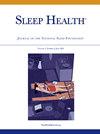SEPAGES 队列中 3 至 60 个月大儿童睡眠多轨迹组的颅内关联。
IF 3.4
2区 医学
Q2 CLINICAL NEUROLOGY
引用次数: 0
摘要
目的:通过识别 3 个月至 60 个月儿童的睡眠多轨迹组别及其与父母睡眠多轨迹组别的关联,研究家庭内部的睡眠演变:我们通过识别3至60个月大儿童的睡眠多轨迹群组及其与父母睡眠多轨迹群组的关联,研究了家庭内部的睡眠演变:我们从 SEPAGES 群体(法国格勒诺布尔)中纳入了 180 名儿童,他们的父母在产后 3 个月至 36 个月期间通过基于群体的多轨迹建模属于先前确定的睡眠多轨迹群体,我们使用了夜间(NSD)和周末白天(DSD)睡眠持续时间和主观睡眠损失,包括 "无"、"主观 "和 "全面 "睡眠问题群体。儿童睡眠信息(NSD、DSD、主观睡眠损失、夜醒和睡眠开始困难)由家长在 3 个月、12 个月、36 个月和 60 个月时进行的问卷调查收集。我们利用基于群体的多轨迹模型确定了儿童睡眠多轨迹群体,并利用多项式逻辑回归分析了这些群体与父母睡眠多轨迹群体之间的关联:我们确定了三个儿童睡眠多轨迹组:"无/极少 "组(29.4%)有中度NSD、长DSD、低主观失眠/夜醒/睡眠开始困难发生率;"中度 "组(60.0%)的 NSD 和 DSD 较长,主观睡眠损失/夜醒/睡眠发作困难发生率中等;"全面 "组(10.6%)的 NSD 和 DSD 最短,主观睡眠损失/夜醒/睡眠发作困难发生率最高。在对协变量进行调整后,"全面 "组的母亲更有可能生下同组的孩子,而 "主观 "组和 "全面 "组的母亲生下 "中度 "组孩子的可能性低于 "无/少 "组。结论:所观察到的亲子睡眠之间的关系与父亲或夫妇睡眠多轨迹组没有关联:结论:观察到的亲子睡眠多轨迹组之间的关联表明,与父亲相比,母亲对孩子睡眠的敏感度更高,或更多地参与到孩子的睡眠中。早期预防性睡眠措施可改善儿童和母亲的睡眠状况。本文章由计算机程序翻译,如有差异,请以英文原文为准。
Intrafamilial associations of sleep multitrajectory groups between ages of 3 and 60 months in the SEPAGES cohort
Objectives
We investigated intrafamilial sleep evolution by identifying children’s sleep multitrajectory groups between 3- and 60-month of age and their association with parental sleep multitrajectory groups.
Methods
We included 180 children from the SEPAGES cohort (Grenoble, France) whose parents belonged to previously identified sleep multitrajectory groups, through group-based multitrajectory modeling, between 3 and 36 months postpartum, using nighttime (NSD) and weekend daytime (DSD) sleep durations and subjective sleep loss, comprising “No,” “Subjective,” and “Global” sleep problems groups. Child sleep information (NSD, DSD, subjective sleep loss, night waking, and sleep onset difficulties) was collected by parental questionnaires at 3-, 12-, 36-, and 60-month. We identified sleep multitrajectory groups using group-based multitrajectory modeling in children and examined their associations with parental sleep multitrajectory groups using multinomial logistic regressions.
Results
We identified three sleep multitrajectory groups in children: the “No/few” group (29.4%) had moderate NSD, long DSD, low subjective sleep loss/night waking/sleep onset difficulties prevalence, the “Moderate” group (60.0%) had long NSD and moderate DSD, and medium subjective sleep loss/night waking/sleep onset difficulties prevalence, and the “Global” group (10.6%) had the shortest NSD and DSD, and the highest subjective sleep loss/night waking/sleep onset difficulties prevalence. After adjusting for covariates, mothers in the “Global” group were more likely to have children in the same group, and mothers in “Subjective” and “Global” groups were less likely to have children in the “Moderate” group than in the “No/few” group. No association was identified with paternal or couple sleep multitrajectory groups.
Conclusions
The observed associations between parent-child sleep multitrajectory groups suggest greater maternal sensitivity to or involvement in the child’s sleep than the fathers. Early preventive sleep actions could improve sleep in children and mothers.
求助全文
通过发布文献求助,成功后即可免费获取论文全文。
去求助
来源期刊

Sleep Health
CLINICAL NEUROLOGY-
CiteScore
6.30
自引率
9.80%
发文量
114
审稿时长
54 days
期刊介绍:
Sleep Health Journal of the National Sleep Foundation is a multidisciplinary journal that explores sleep''s role in population health and elucidates the social science perspective on sleep and health. Aligned with the National Sleep Foundation''s global authoritative, evidence-based voice for sleep health, the journal serves as the foremost publication for manuscripts that advance the sleep health of all members of society.The scope of the journal extends across diverse sleep-related fields, including anthropology, education, health services research, human development, international health, law, mental health, nursing, nutrition, psychology, public health, public policy, fatigue management, transportation, social work, and sociology. The journal welcomes original research articles, review articles, brief reports, special articles, letters to the editor, editorials, and commentaries.
 求助内容:
求助内容: 应助结果提醒方式:
应助结果提醒方式:


